| Author |
Message |
Roger Hooper

|
 Posted: Sun 23 Feb, 2014 3:20 pm Post subject: Albion Maestro Marozzo Side Sword Posted: Sun 23 Feb, 2014 3:20 pm Post subject: Albion Maestro Marozzo Side Sword |
 |
|
I just received the Albion Maestro Marozzo Side Sword. This is my tenth Albion, my first in five years.
Up front, to satisfy our obsession with specifications - (in inches):
Overall Length – 44
Blade Length (includes Ricasso) – 37.5
Ricasso Length - 2
Grip Length – 3.625
Guard Width – 8.188
Blade Width –
Ricasso -.938
Just Below Ricasso – 1.5
Midpoint – 1
2 inches before tip - .635
Blade Thickness –
Ricasso - .250
Just Below Ricasso - .250
Down 9 inches from guard - .195
Down 18.5 inches from Guard - .154
Down 27 inches from Guard - .120
2 inches from tip .098
--61% total Distal Taper--
COG - 4.375
COP – 25 (not that I’ll be cutting anything with it)
Weight (from Albion) – 2.5 lbs.
This is classified as a reenactment/stage combat sword – I hope to use it the second capacity. It has rolled edges which should protect it from too much nicking. I measured them at 3mm, though I may not have been doing it correctly.
The bottom half (foible?) of the blade has some flex to it. The forte is pretty stiff. This is good for stage combat, since an inadvertent full thrust hit will hopefully flex enough to prevent broken bones, etc. There was some criticism of some of the prototype versions of this model, that the blade had too much flex, and that it was too whippy. That problem has been solved – not whippy anymore, though this may not satisfy those that want a blade stiff from guard to tip.
The sword weighs 2.5 lbs, but is no lightweight. It definitely does not feel like a modern fencing sword – it has a lot more bottom to it. The width starts out a 1.5 inches, wider that many rapiers – it is certainly a cut and thrust type side sword, though the blade may be longer than most of that kind. The broad, blade-length fuller and the 61% distal taper help to make the sword very maneuverable and easy to wield. One of the reasons that much taper works so well, may be that it starts out at .250, thicker than most other blades. The design of this model is a series of compromises. On the one hand, you want to make it look and handle as much like a real sword as you can – On the other, you need to make it strong, durable, and safe. Many blunts are either not strong enough, or end up being almost like crowbars. Albion has achieved an admirable balance here.
Some minor points against it –
1) It has that ugly beige Maestro grip – functional, but unaesthetic to the max.
2) The hilt is made of some variety of stainless steel. That’s no problem for me, but, like all Maestros, the finish is a little rough. There are some minor imperfections to be seen. Of course, a better finish and grip would have raised the price, already high for a reenactment sword.
3) For me at least, the blade is about 4 inches too long for a side sword. That won’t be a problem for many.
Though I haven’t yet put it to the test, I can safely say that the Marozzo, and all the other Maestros are at the top of the heap, with only the A&A practice models in contention with them. It’s a great looking and functional (for its purpose) sword, and I hope to start using it soon.
 Attachment: 98.58 KB Attachment: 98.58 KB
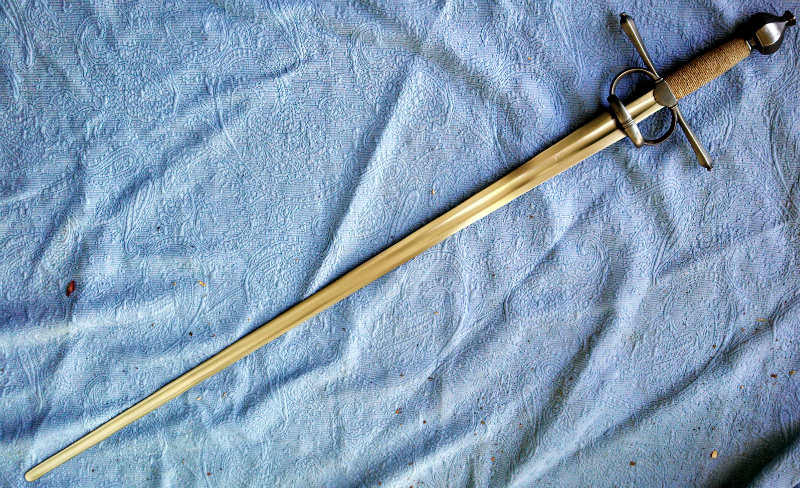
 Attachment: 97.67 KB Attachment: 97.67 KB
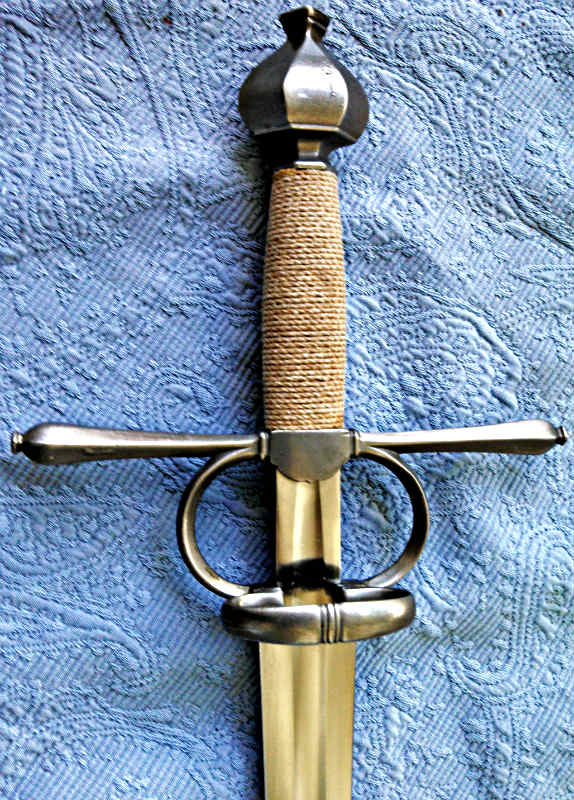
 Attachment: 99.01 KB Attachment: 99.01 KB

 Attachment: 99.46 KB Attachment: 99.46 KB
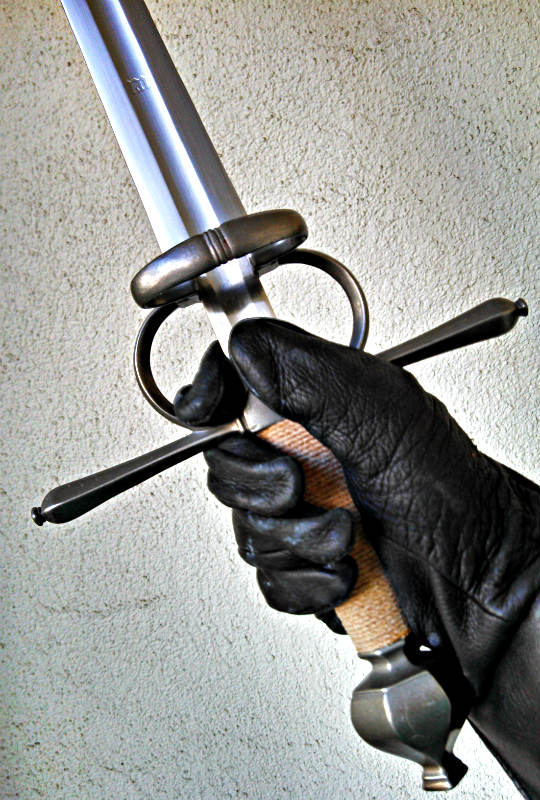
Last edited by Roger Hooper on Wed 26 Feb, 2014 9:39 am; edited 1 time in total
|
|
  |
 |
|
D. S. Smith
Location: Central CA Joined: 02 Oct 2011
Posts: 236
|
 Posted: Sun 23 Feb, 2014 11:24 pm Post subject: Posted: Sun 23 Feb, 2014 11:24 pm Post subject: |
 |
|
Thanks for the review, Roger. I'm incredibly jealous! I'm not sure if you saw this thread of mine:
http://www.myArmoury.com/talk/viewtopic.php?t=29706
... I used your new sword as an example of one I really like the looks of. If Albion made a sharp "battle ready  " version of that sword and were able to keep the fuller and appearance, I'd be first in line to buy one. It is an absolutely gorgeous sword, and I even like it better because of the rougher hilt furniture and two-tone metal shade with the hilt being darker than the blade, but not as dark as blued. If I was looking for a practice sword that's the exact one I'd buy. " version of that sword and were able to keep the fuller and appearance, I'd be first in line to buy one. It is an absolutely gorgeous sword, and I even like it better because of the rougher hilt furniture and two-tone metal shade with the hilt being darker than the blade, but not as dark as blued. If I was looking for a practice sword that's the exact one I'd buy.
|
|
  |
 |
Nathan Robinson
myArmoury Admin


|
 Posted: Mon 24 Feb, 2014 7:16 am Post subject: Posted: Mon 24 Feb, 2014 7:16 am Post subject: |
 |
|
Not having handled the sword in person and never to rely on photos (been wrong too many times!), I'm curious: Do you find the hilt oversized in any way? It seems very large for the type, though I've got nothing short of 100% confidence in Albion's design choices to convince me it would be "wrong"... more curious about your impression and personal opinion.
.:. Visit my Collection Gallery :: View my Reading List :: View my Wish List :: See Pages I Like :: Find me on Facebook .:.
|
|
    |
 |
Roger Hooper

|
 Posted: Mon 24 Feb, 2014 7:43 am Post subject: Posted: Mon 24 Feb, 2014 7:43 am Post subject: |
 |
|
Hello D.S. -
Yes, I remember that thread. A number of people have said that they wished Albion would make a sharp version of this model. If they did, the blade would have big differences from the Marozzo. The fuller would be shorter and much narrower. The blade-length, wide fuller is part of their strategy to make the blade both strong and nimble. I don't think you'd find many early 16th century blades like this one. Take a look at some of A&A's swords like the Milanese and the Gustav Vasa for some sharp models that might interest you.
Nathan, when the sword arrived, it didn't stand out to me as being oversized, but as I look at it again, I see areas that could easily have been smaller. The grip could have been an inch shorter. The pommel has a 2 inch diameter which could have been reduced. I wouldn't want the guard width to be shortened. The thing that stands out is the length of the pas d'anes, which at 2 inches could have been shortened by 1/2 inch and still have room for your finger. Still, everything is in proportion, and the sword looks great and handles great.
Even though the cast hilt is a little rough, it does have some fine detailing on the pommel, and on the compound guard, especially around the rings.
It would be interesting if someone could compare the Marozzo to A&A's side sword trainer. They are in the same price range.
Here are a couple more photos showing some new angles
 Attachment: 98.43 KB Attachment: 98.43 KB
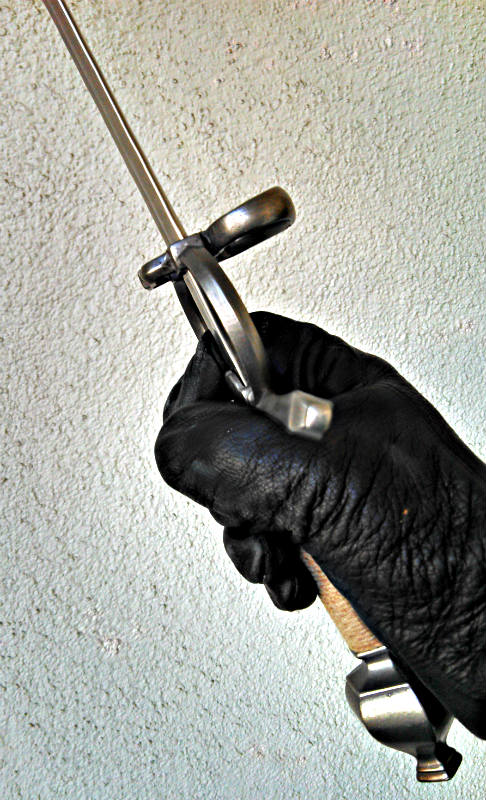
 Attachment: 94.94 KB Attachment: 94.94 KB
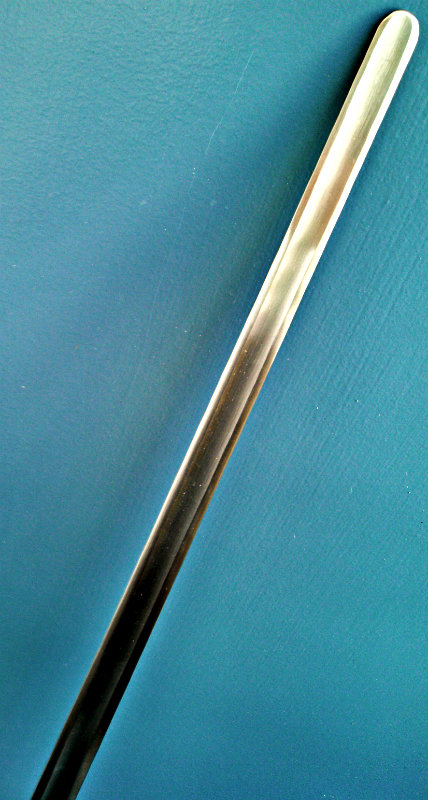
|
|
  |
 |
|
Henrik Granlid
|
 Posted: Mon 24 Feb, 2014 10:22 am Post subject: Posted: Mon 24 Feb, 2014 10:22 am Post subject: |
 |
|
An excellent review for a beautiful blade.
Although on the side-topic of sharp versions, there is the Doge and the Machiavelli for swords in a similar vein, although I am not well versed enough in the era of sideswords and smallswords to accurately comment on it, but to me, they look "Close enough" and they both feel marvelous to handle (got to try both when visiting Albion Europe to pick up my Liechtenauer last year)
|
|
  |
 |
Roger Hooper

|
 Posted: Mon 24 Feb, 2014 4:10 pm Post subject: Posted: Mon 24 Feb, 2014 4:10 pm Post subject: |
 |
|
Let me amend what I said before - while a 10% smaller version of this sword would appeal to me, consider that the prototypes were in R & D for a few years. I imagine that Albion experimented with a number of variations, and , after a few iterations, decided on this final version.
 Attachment: 99.45 KB Attachment: 99.45 KB
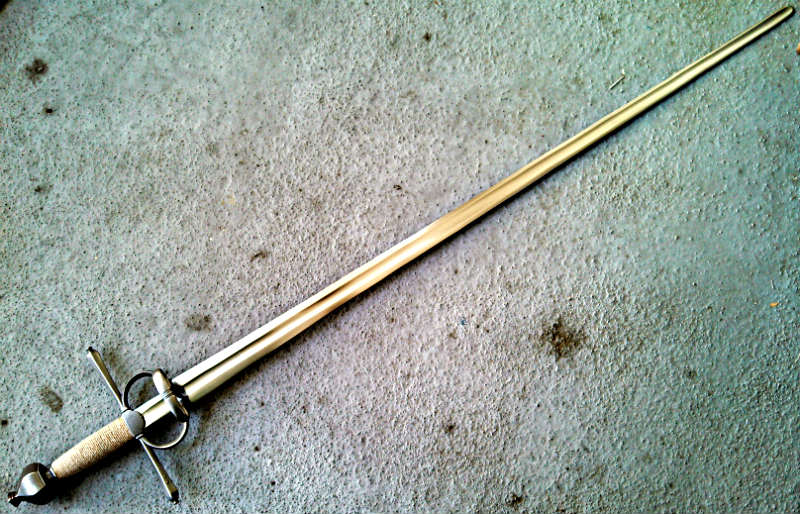
|
|
  |
 |
|
D. S. Smith
Location: Central CA Joined: 02 Oct 2011
Posts: 236
|
 Posted: Mon 24 Feb, 2014 9:21 pm Post subject: Posted: Mon 24 Feb, 2014 9:21 pm Post subject: |
 |
|
Thanks for the additional photos and explanations, Roger. I hear what you're saying about the blade geometry needing to change for a sharp version. I don't mean I'd like to see the sharp version with a full-length fuller, I'd just love to see this same Marozzo length (or even a tiny bit shorter), with the fuller the same width at the hilt, and maybe terminating 1/3 to 1/2 way down the blade. I'm picturing like a type XVI or XVII. I know it would alter the handling, but I think they could still make a very sweet handling sword using the first third of this blade and hilt as a base platform.
From the great historical examples people have shown in the other thread, it seems that this is a sword type that is not very well represented in the reproduction market, but with plenty of nice historical fact behind it.
|
|
  |
 |
|
Mark Nelson
|
 Posted: Wed 26 Feb, 2014 8:36 pm Post subject: Posted: Wed 26 Feb, 2014 8:36 pm Post subject: |
 |
|
I'll add my voice to the praise of this sword. It feels great, and Albion has done a wonderful job in creating a practice version of their type XIX swords. There is barely any difference in handling and weight distribution between this and my Machiavelli.
I do have to disagree with Roger about the blade being too long. I am average height (5'8") and it feels just right.
|
|
   |
 |
Vincent Le Chevalier

|
 Posted: Thu 27 Feb, 2014 12:18 am Post subject: Posted: Thu 27 Feb, 2014 12:18 am Post subject: |
 |
|
I like the blade design and the length. I think many sidesword trainers tend to be shorter than originals and this influences the play somewhat.
That being said, from what I heard the flex is a bit too much. I hope to see it in person one day, so far I'm basing that on reviews and other people's comparison with my own sword.
But the biggest thing for me is that this form of hilt is not protective enough. It would force me to wear a much heavier glove for training. That's why I don't think I'll ever buy this sword.
Regards,
--
Vincent
Ensis Sub Caelo
|
|
   |
 |
|
T. Kew
Location: London, UK Joined: 21 Apr 2012
Posts: 256
|
 Posted: Thu 27 Feb, 2014 3:13 am Post subject: Posted: Thu 27 Feb, 2014 3:13 am Post subject: |
 |
|
| Vincent Le Chevalier wrote: | I like the blade design and the length. I think many sidesword trainers tend to be shorter than originals and this influences the play somewhat.
That being said, from what I heard the flex is a bit too much. I hope to see it in person one day, so far I'm basing that on reviews and other people's comparison with my own sword.
But the biggest thing for me is that this form of hilt is not protective enough. It would force me to wear a much heavier glove for training. That's why I don't think I'll ever buy this sword.
Regards, |
Hm. My impression has been that the complaints about the flex have primarily been from some groups who believe that rapier-esque swords should have no flex whatsoever, which is both inaccurate and also not applicable to this sidesword trainer. If you require all your thrusting swords to be as stiff and inflexible as a wooden waster, this is not the sword for you.
The hilt is a rather sparse affair, but that's also quite accurate for lots of earlier sidesword texts, so the problem of defending your hand is one they'd have faced as well.
|
|
  |
 |
Vincent Le Chevalier

|
 Posted: Thu 27 Feb, 2014 10:32 am Post subject: Posted: Thu 27 Feb, 2014 10:32 am Post subject: |
 |
|
| T. Kew wrote: | | Hm. My impression has been that the complaints about the flex have primarily been from some groups who believe that rapier-esque swords should have no flex whatsoever, which is both inaccurate and also not applicable to this sidesword trainer. If you require all your thrusting swords to be as stiff and inflexible as a wooden waster, this is not the sword for you. |
I don't think I'm shooting for something quite that inflexible  My Danelli has just about the right amount (not just from my opinion but also from others in my group, which is quite "standard" gear wise). I've been told that the Albion is significantly more flexible than that. My Danelli has just about the right amount (not just from my opinion but also from others in my group, which is quite "standard" gear wise). I've been told that the Albion is significantly more flexible than that.
But then it's only hearsay, and on one specific example. Maybe it is an odd piece...
| Quote: | | The hilt is a rather sparse affair, but that's also quite accurate for lots of earlier sidesword texts, so the problem of defending your hand is one they'd have faced as well. |
Yes it's certainly accurate, but at the level of contact of most HEMA groups (even outside competition) you'll need a relatively heavy glove to do freeplay with it. Since more protective hilts are historical as well I'd rather use them than have to cope with a clumsy (and costly!) glove.
This might be the reason for the slight oversizing that Nathan noticed, by the way. Fitting good protective gloves in historically sized finger rings can be quite hard...
Regards,
--
Vincent
Ensis Sub Caelo
|
|
   |
 |
Roger Hooper

|
 Posted: Thu 27 Feb, 2014 1:39 pm Post subject: Posted: Thu 27 Feb, 2014 1:39 pm Post subject: |
 |
|
A couple of points -
As to blade length - yes, side swords came in a range of lengths. However, since Albion says of the Marozzo, "This sword would be an equivalent to Albion Type XIX cut and thrust swords", and it can be used as a training equivalent to them, one would think that it should have a similar blade length to a Condottiere, Kern, or Machiavelli - around 33.5 inches.
As to the flex question, as I mentioned earlier, most of this comes from Arma evaluation of a prototype Marozzo from a few years ago, where it was characterized as a "metal noodle". The finished product is different from that prototype, though it does have intentional flex in the foible. Again, if you want a completely stiff blade, this model is not for you.
I was able to recover secondhand something that Peter Johnsson wrote on Facebook about the Marozzo. Peter, I hope you don't mind my quoting this:
The blade of the Marozzo is a good combination of stiffness and flexibility, just like many of the original swords of the type it is made to simulate. The outer third has some flex to it, to make thrusting less dangerous, but it is no noodle because of this. It is not made to be *more* flexible than a "live" or sharp original blade. As the Marozzo aims to simulate those light, swift and handy side swords that were favored in the period that belongs to Marozzo´s Opera Nova, it *has* to exhibit a degree of flexibility, or it would not be faithful to the type.
It is common to find very whippy blades on blunt training swords. Many modern swordsmen abhor this, and so do I.
The most common reason for this is that the point section is left too thick and the base is too thin to carry the mass of the blade. The base and mid section of the blade must be made thicker in proportion to the point to avoid a wobbly blade. This is exactly what I have done in the design of the Marozzo blade. It is cut from a thicker stock that allows for a more dynamic variation in the distal taper. It makes for more expenses in materials used, but I believe it is well worth it since it allows for a much more realistic and agile blade.
The Marozzo has a sturdy base and mid section. It is actually stiffer than some original swords of this type. Your criticism is to me difficult to understand as you by saying this about the Marozzo you will also disqualify a large proportion of the original swords since they are too flexible in your pinion. Yet, the very same blades seemes to have done the trick for the ancient masters of the sword.
Different swordsmen surely have different ideas for what an ideal sword should look like and behave. It is impossible for one sword to please all tastes. The Marozzo is a good representative of these light "cut and thrust" swords with blades of moderate length belonging to the first half of the 16th century. Since these swords were intended for the cut as well as the thrust, the point has to be thin and fast. They tend to be broader than "true" rapiers (and I do not like that term). They are shorter and wider and because of this also thinner.
My suggestion is to approach this sword with an open mind and see why it did not work for those swordsmen. It might be that it is not the sword that is at fault, but that there is something that can be adjusted in the interpretation of the fighting style. I know that at least John Clements has a personal preference for stiffer blades. But that does not mean that all those originals with more flexible blades are flawed.
|
|
  |
 |
|
Johan Elder
Location: Montreal, QC, Canada Joined: 26 Feb 2012
Posts: 7
|
 Posted: Thu 27 Feb, 2014 2:11 pm Post subject: Posted: Thu 27 Feb, 2014 2:11 pm Post subject: |
 |
|
That quote from Peter Johnsson is just what I thought of reading through this discussion.
As for my 2 cents. I have been training Dall Agochie's sidesword for a little over a year and a half. For most of that time we used synthetic arming swords, with a blade length of around 31-32". Another member of my group received a Marozzo (he was one of the pre-order people), and shortly after I received mine.
I must say that the first time we used the 2 Marozzo's together, in drilling and in sparring, it was an eye opener. A significant number of the plays, that 'worked' with arming swords, worked so much more effortlessly with the longer Marozzo blade.
I have, twice so far, wished that the complex guard was more.. complex. But to be honest, those 2 hits to my hand were more a product of a poorly executed guardia di testa than anything else. Better gauntlets than lacrosse gloves will be nice (waiting for a pair of BlackLance), but gloves will never be a substitute for better fencing. Just nice to have for accidents.
|
|
  |
 |
Vincent Le Chevalier

|
 Posted: Thu 27 Feb, 2014 2:52 pm Post subject: Posted: Thu 27 Feb, 2014 2:52 pm Post subject: |
 |
|
I had seen Peter's answer before hearing first hand accounts, actually. Because of that, I wasn't expecting people to point this sword out as too flexible, but that's what happened. Again, I'll wait until I see an example in person, but it's something I would check. Here is a review in French. The caption of the picture showing the flex says 'although it's not obvious, this is from the pressure of a single finger'. Again, it could be specific to that specific sword. The same guy has a Meyer that is reputedly a lot more rigid than most, so it might be the quality control on that aspect that is off, rather than Peter's design. I don't know...
Regards,
--
Vincent
Ensis Sub Caelo
|
|
   |
 |
|
|
You cannot post new topics in this forum
You cannot reply to topics in this forum
You cannot edit your posts in this forum
You cannot delete your posts in this forum
You cannot vote in polls in this forum
You cannot attach files in this forum
You can download files in this forum
|
All contents © Copyright 2003-2025 myArmoury.com — All rights reserved
Discussion forums powered by phpBB © The phpBB Group
Switch to the Basic Low-bandwidth Version of the forum
|

